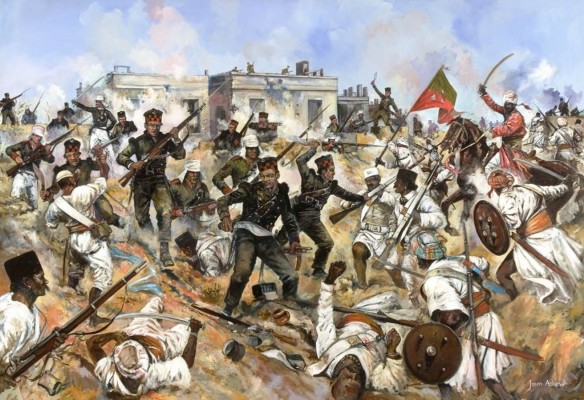The 2nd Gurkhas at Delhi-1857
A major challenge to the British Empire was the Indian Mutiny of 1857-1859, which led to the largest deployment of British forces between the Napoleonic Wars and the Boer War of 1899-1902. Victory was seen as crucial to British prestige and power in India. Many factors contributed to discontent among the Indian troops, and more generally in India. Given the strategic needs of British power, it is striking that a major cause of tension was the reluctance of many soldiers to serve abroad for caste reasons, and the newfound determination of the authorities to ensure that they were able to do so. This was understandable given the military resource India provided. For example, in 1838-1846, Indian troops had been very useful in the conquest of north Borneo and Labuan. The trigger for the rising was the British demand that their Indian soldiers use a new cartridge for their new Lee-Enfield rifles allegedly greased (to keep the powder dry) in animal fat, a measure that was unacceptable to Muslims and Hindus for religious reasons, although there was a concerted plan for mutiny with communications between the rebels long before the issue of cartridges. This was significant because of the low level of confidence between British officers and Indian subordinates: the army in India in 1857 contained about 232,000 Indian and 45,000 British troops. Most of the Indian troops in this army’s largest section, the Bengal army (which comprised 135,000 Indian and 24,000 British troops), mutinied in May 1857, while there was also a large-scale civilian rising in north-central India. The garrison of Meerut mutinied on 10 May, and Delhi was seized the next day.
Fortunately for the British, much of the Indian army remained loyal (the Madras and Bombay armies, and about 30,000 sepoys of the Bengal army) and the rulers of Hyderabad, Kashmir, and Nepal provided assistance, helping ensure that the British outnumbered the rebels in many of the clashes in 1858. No major prince joined the rebellion, and it also had no foreign support: Afghanistan provided no support for the rebellion. Furthermore, the movement of British troops into the region, and the inability of the badly led rebels, who lacked effective coordination or indeed a clear program, to spread the rebellion, helped the British regain the initiative, storming Delhi and clearing the city in bitter street fighting in September 1857. Nevertheless, the campaign revealed serious flaws in the British military system, not least over transport and medical services. In the spring of 1858, the British overran the rebellious area, capturing Lucknow on 22 March, Jhansi on 3 April, and Kalpi on 22 April. Thanks to impressive generalship by Sir Hugh Rose, who understood the need for effective logistics, the rebellion in central India was ended in June with the capture of Gwalior and victory at Jaura-Alipur. Peace was officially declared by the Governor-General on 8 July 1858, although small-scale resistance continued, with a fresh rising at Multan in August 1858. However, the last battle was at the Sirwa Pass on 21 May 1859, on the frontier of Nepal. The defeated remnants fled into Nepal.
The Mutiny led, in 1858, by the India Act, to the end of rule by the East India Company, and, instead, to the direct administration by the British government of what was not left under dependent local princes, a system that continued until India gained independence in 1947. The British also became more cautious in their treatment of Indian opinion, not least in their willingness to consider unwelcome reforms. Caution owed something to the bitterness and racial violence of the struggle, and the longstanding images of cruelty it provided. For the British, this was the case with mutineers massacring women, children, civilians, and prisoners, as at Cawnpore in June-July 1857. In contrast, Colin Campbell’s ability to lead a column to the relief of Lucknow in November 1857 became a totemic occasion of Victorian soldiering and served as a model for subsequent actions, while Henry Havelock and other commanders demonstrated Christian militarism. However, there were alternative images of cruelty, with British troops killing captured mutineers, most dramatically by strapping them across the muzzles of cannon which were then fired. In modern India, the Mutiny was reinterpreted, somewhat anachronistically, as India’s first war of independence or nationalism, and is now widely referred to as the “Rebellion.”
Once the Mutiny was suppressed, India returned to its former role as a key support for British power elsewhere, including China. The separate local army, however, was now abolished, while the percentage of British troops among the forces in India was greatly increased, and the artillery became nearly all British. Furthermore, the Gurkhas and Sikhs, groups who had remained loyal, became increasingly important among the Indian troops, at the expense of Brahmins, many of whom had rebelled.
